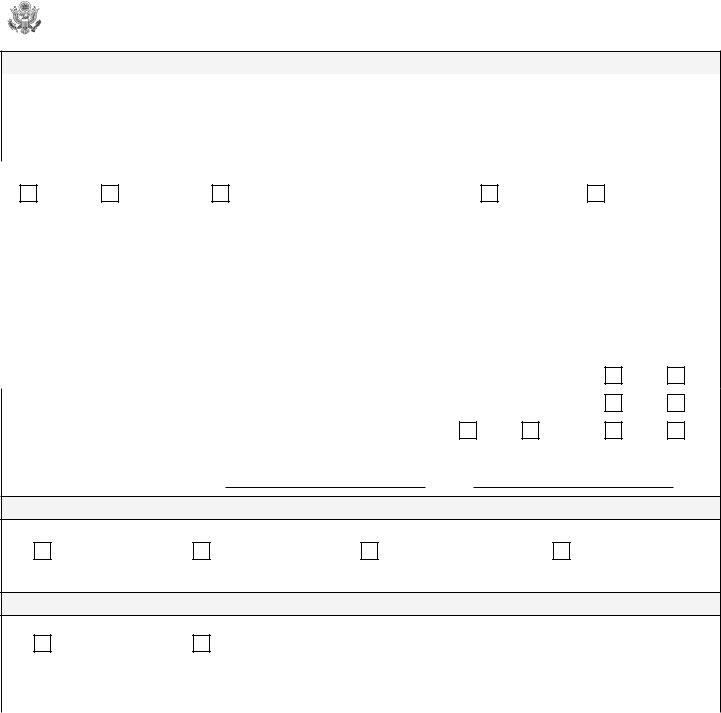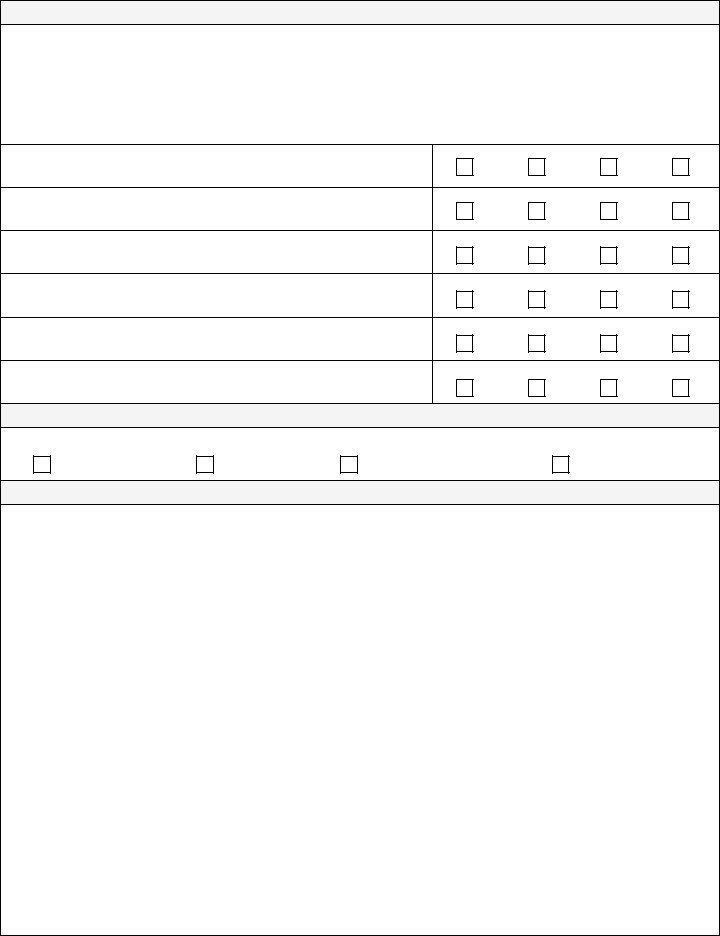The JF-50 form, issued by the U.S. Department of State, serves as a comprehensive tool for evaluating the performance of locally employed staff, including Foreign Service Nationals and ordinarily resident employees. Designed to promote clarity and objectivity in the appraisal process, this form instructs raters on how to assess employees accurately across various sections. Section 1 collects essential employee data including name, position title, rating period, and grade, which set the foundation for a thorough evaluation. The performance report distinguishes between regular, probationary, and interim reports, tailoring the evaluation to the employee's current career stage. Critical to the process, the form mandates the rater's certification regarding the accuracy of position descriptions and the necessity of performance discussions. With a detailed section on job element appraisals, the form encourages raters to select and evaluate key job elements against performance standards—Exceptional, Good, Needs Improvement, and Unsatisfactory—providing a structured way to capture the nuances of each employee's contributions and areas for improvement. The inclusion of both a rater and reviewer in the process underscores the importance of multiple perspectives in assessing performance fairly. Furthermore, the form accommodates employee engagement by allowing for a review request and the submission of an employee's statement, thereby ensuring a participatory evaluation process.
| Question | Answer |
|---|---|
| Form Name | Jf 50 Form |
| Form Length | 7 pages |
| Fillable? | No |
| Fillable fields | 0 |
| Avg. time to fill out | 1 min 45 sec |
| Other names | jf50, jf50 pdf, form jf 50, usaid forms jf 50 |

U.S. Department of State
EMPLOYEE PERFORMANCE REPORT (EPR)
INSTRUCTIONS FOR COMPLETION
Section 1 - Employee Data
1. Name
Enter the employee's full name.
2. Position Title
The position title shows the official title assigned and used on CAJE evaluation. The rater cannot use
Example:
Correct: Human Resources Specialist
Incorrect: Senior Human Resources Management
Supervisor
3. Rating Period
The Rating Period shows the actual dates of the performance period being evaluated.
4. Grade
The grade shows the official grade assigned and used on CAJE evaluation.
Example:
5. Type of Report
Regular- A report that covers performance for a period of one year is a Regular Report.
Probationary- A report prepared upon completion of the probationary period is a Probationary Report.
Interim- A report covering a time period of less than one year is an Interim Report, unless covering a probationary period of less than one year. The Rater gives the reason for an interim report.
6. Training or Developmental Grade
Checking Y (Yes) certifies that the employee is being rated at less than the full performance grade of the position.
7. and 8. Post and Agency
Enter the post and agency of employment.
9. Date of Position Description
Enter the date of the most recent Position Description and Job Discussion Help Sheet CAJE evaluated by post HR.
10. and 11. Rater and Reviewer
Enter the full name of the Rater and official job
title and grade, and, if appropriate, the full name of the Reviewer and official job title and grade.
Section 2 - Certifications (Continued)
14. Probationary Rating
The Rater certifies the level of overall performance, and recommends (a) the employee for continued service with the U.S. Government; (b) extension of the probationary period to further assess the employee's potential for
15. Discussion of Performance
The Rater certifies that there was at least one discussion of performance with the employee during the rating period. The Rater writes down all the dates during the rating period when performance was discussed with the employee.
Section 3 - Overall Summary Rating
16.An Overall Summary Rating is required for every type of report: Regular, Probationary, or Interim.
The Performance Standards are the criteria used to determine the Overall Summary Rating. The Overall Summary Rating doesn't have to be an average of ratings on individual job elements. It should reflect the Rater's assessment of overall performance, taking the relative importance of each element into account.
Section 4 - Employee Request for a Higher Level Review by the Reviewer
17.The employee checks the appropriate box requesting or declining the opportunity for a review by a Reviewer, unless a review is mandatory because:
A.The Rater is not an American direct hire Foreign Service, Civil Service, or uniformed service member officially assigned to post and under Chief of Mission authority; or
B.The Rater gives a Rater Summary Rating of Unsatisfactory.
Unless a review is required, the employee has five work days from the date of receiving the completed EPR by the Rater to ask for a higher level review. If a review is requested, the employee has five work days to provide formal or informal written comments to the Reviewer.
Section 2 - Certifications
12. Position Description
The Rater certifies that the Position Description is a current and accurate reflection of the major components of assigned work.
13. Overall Summary Rating
The Rater certifies the level of overall performance, and either authorizes or denies the
Section 5 - Signatures
18.Completing this section certifies that the Rater and employee had at least one discussion of performance during the rating period, and reviewed the contents of the rating. The employee's signature does not necessarily constitute agreement with the rating.
If a Review was required or requested, the Reviewer also signs Section 5 confirming Section 9 and 10 of
the EPR.
Instruction Page 1 of 3 |
|
|

INSTRUCTIONS FOR COMPLETION (Continued)
Section 6 - Job Elements
19.Employees are evaluated using four job element performance standards: Exceptional, Good, Needs Improvement, and Unsatisfactory.
Within 30 calendar days of the new rating period, the Rater selects a minimum of three, but no more than six, critical job elements from the position description for evaluation. The Rater puts them on the Work and Development Plan (WDP) and then, when it is time to complete the EPR, summarizes each element in
Section 7 - Rater Summary Rating
20.The Performance Standards are the criteria used to determine the Rater Summary Rating. When no Reviewer evaluation is required, or none is requested by the employee, the Rater Summary Rating is also used as the Overall Summary in Section 3.
Section 8 - Rater Narrative Summary
21.The Rater is required to complete a narrative summary on the overall performance of the employee when:
A.The Rater Summary Rating or Overall Summary Rating is Exceptional, Needs Improvement or Unsatisfactory; or
B.Post policy requires a narrative for all employees.
Section 9 - Reviewer Summary Rating
22.A Reviewer Summary Rating is required if:
A.The Rater is not an American direct hire Foreign Service, Civil Service, or Uniformed Service member officially assigned to post and under Chief of Mission authority; or
B.The employee receives a Rater Summary Rating of Unsatisfactory; or
C.The employee requests it.
The Performance Standards are the criteria used to determine the Reviewer Summary Rating.
Section 10 - Reviewer Narrative Summary
23.If a review is required, the Reviewer must complete a narrative summary on the overall performance of the employee when:
A.The Reviewer Summary Rating is Exceptional, Needs Improvement, or Unsatisfactory; or
B.Post policy requires a Reviewer narrative for all employees.
Section 11 - Employee's Statement
24.The employee is encouraged to complete an Employee's Statement to comment on his or her performance for the rating period.
Section 12 - Submission and Distribution
25.Post HR checks the appropriate sentence in Section 12 and distributes the original EPR and copies as follows:
Original: Employee Performance File (EPF)
1 Copy: Employee
Section 13 (Optional) - Performance Factors
26.The Rater chooses whether or not to complete this section, although it is encouraged as a tool to enhance employee growth and development.
Section 13 provides generic definitions of each performance factor to assist the Rater in completing this optional section of the EPR.
Instruction Page 2 of 3 |

EMPLOYEE PERFORMANCE REPORT (EPR)
PERFORMANCE STANDARDS
Exceptional
This is a level of rare, high quality performance. As a general rule, only two to five percent of employees within a section or agency will rate as Exceptional. The quantity and quality of the employee's work substantially exceeds the good standard and rarely leaves room for improvement. The accuracy and thoroughness of the employee's work are exceptionally reliable. Application of technical knowledge and skills goes beyond that expected for the position. Following procedures and formats, as well as suggestions for improvement in these procedures and formats, increases the employee's value.
Good
This is a level of consistently successful, sound performance. The quality and quantity of the employee’s work meets or exceeds expectations. The performance represents a dependable level of competence reflecting an ability to work independently without complaint from customers. Tasks are completed in an accurate, thorough, and timely way. The employee reliably adheres to procedures and format requirements, follows the instructions of the supervisor, provides valuable input to the supervisor, and is an ongoing, dependable contributor to the goals of the Mission.
Needs Improvement
This is a minimum level of performance for continued employment. The quality and quantity of the employee's work are below the level of most employees, but the Rater believes improvement is possible. The Rater experiences at least one of the following aspects of performance:
Tasks are not completed with the needed degrees of accuracy and thoroughness. Application of technical knowledge and skills is not reliable.
Inappropriate variations from policies, procedures, and instructions interfere with completion of work and the work of others.
Inadequate work planning leads to missed deadlines.
The employee's behavior toward the supervisor,
Unsatisfactory
This is an inadequate level of performance. The quality and quantity of the employee's work consistently do not meet the assigned work requirements of the position. The Rater experiences at least one of the following aspects of performance:
Tasks often are submitted late, or require major revision because they are incomplete or
inaccurate.
Despite training, the knowledge applied does not produce the needed results.
Inappropriate variations from policies, procedures, and instructions get in the way of completing the employee's own work and the work of others.
The employee's behavior obstructs the successful completion of the work by self and others and disrupts cooperation within the work unit.
Instruction Page 3 of 3 |

U.S. Department of State
EMPLOYEE PERFORMANCE REPORT (EPR) FOR LOCALLY EMPLOYED STAFF
FOREIGN SERVICE NATIONALS AND ORDINARILY RESIDENT EMPLOYEES
Section
1. Name (Last, First, MI.) |
|
|
|
|
|
2. Position Title |
|
|
|
|
|
|
||||||||||
|
|
|
|
|
|
|
|
|
|
|
|
|
|
|
|
|
|
|
|
|
|
|
3. Rating Period |
|
|
|
|
|
|
|
|
|
|
4. Grade |
|
|
|
|
|
|
|||||
From |
To |
|
|
|
|
|
|
|
|
|
||||||||||||
|
|
|
|
|
|
|
|
|
|
|
|
|
|
|
|
|
|
|
|
|
|
|
|
|
|
|
|
|
|
|
|
|
|
|
|
|
|
|
|
|
|
|
|
|
|
5. Type of Report |
|
|
|
|
|
|
|
|
|
|
6. Training or Development Grade |
|
|
|||||||||
|
|
Regular |
|
Probationary |
|
|
|
Interim (Specify) |
|
|
Yes |
|
|
No |
|
|
||||||
|
|
|
|
|
|
|
|
|
|
|||||||||||||
|
|
|
|
|
|
|
|
|
|
|
|
|
|
|
|
|
|
|
|
|
|
|
|
|
|
|
|
|
|
|
|
|
|
|
|
|
|
|
|
|
|||||
|
|
|
|
|
|
|
|
|
|
|
|
|||||||||||
7. Post |
|
|
|
|
|
8. Agency |
9. Date of Position Description |
|||||||||||||||
|
|
|
|
|
|
|
|
|
|
|
|
|
|
|
|
|
||||||
10a. Rater |
|
|
|
|
|
|
|
|
10b. Title and Grade |
|
|
|
|
|
|
|||||||
|
|
|
|
|
|
|
|
|
|
|
|
|
|
|
|
|||||||
11a. Reviewer |
|
|
|
|
|
|
|
|
11b. Title and Grade |
|
|
|
|
|
|
|||||||
|
|
|
|
|
|
|
|
|
|
|
|
|
|
|
||||||||
Section 2 - Certifications |
|
|
|
|
|
|
|
|
|
|
|
|
|
|
||||||||
12. Position Description is current and accurate. |
|
|
|
|
|
|
Yes |
|
No |
|||||||||||||
|
|
|
|
|
|
|
|
|
|
|
|
|
|
|
|
|
|
|
|
|
||
|
|
|
|
|
|
|
|
|
|
|
|
|
|
|
|
|
|
|
|
|
|
|
13. Overall Summary Rating is 'Good' or better and eligible for WGI. |
|
|
|
|
|
|
Yes |
|
No |
|||||||||||||
|
(If no, WGI will be withheld.) |
|
|
|
|
|
|
|
|
|
|
|
|
|||||||||
|
|
|
|
|
|
|
|
|
|
|
|
|
|
|
||||||||
14. Employee on probation is recommended for continued employment. |
N/A |
Extended |
|
Yes |
|
No |
||||||||||||||||
15.A discussion of performance was held on: Date(s)
Section 3 - Overall Summary Rating
16. Overall Summary Rating
Exceptional |
|
Good |
|
Needs Improvement |
|
Unsatisfactory |
If any job element is marked Unsatisfactory, the Overall Summary Rating may not be marked as Good or Exceptional.
Section 4 - Employee Request for a Higher Level Review by the Reviewer (when not otherwise required)
17. I understand that I may request a higher level review of my appraisal report by the Reviewer.
|
|
I do |
|
|
I do not request a higher level review. |
|
|
|||
|
|
|
|
|
|
|
|
|||
|
|
|
|
|
|
|
|
|
|
|
|
|
|
|
|
Signature of Employee |
Date |
||||
|
|
|
|
|
|
|
|
|
||
Section 5 - Signatures |
|
|
|
|
|
|
||||
18. The signatures confirm that the Rater and Employee: |
|
|
||||||||
|
A. Had at least one discussion of performance during the rating period; and |
|
|
|||||||
|
B. Reviewed the contents of the rating. |
|
|
|||||||
The employee's signature does not necessarily constitute agreement with the rating. |
|
|
||||||||
|
|
|
|
|
|
|
|
|||
|
|
|
|
|
|
|
|
|
|
|
|
|
|
|
|
|
Signature of Rater |
Date |
|||
|
|
|
|
|
|
|
|
|||
|
|
|
|
|
|
|
|
|
|
|
|
|
|
|
|
|
|
|
|
||
|
|
|
|
|
Signature of Employee |
Date |
||||
|
|
|
|
|
|
|
|
|
||
|
|
|
|
|
|
|
|
|
||
|
|
Signature of Reviewer (Required only if evaluated by Reviewer) |
Date |
|||||||
|
|
|
|
|
|
|
|
|
|
|
Page 1 of 4 |
|
|

Section 6 - Job Element Appraisals
19.The Rater shall select between three to six critical job elements from the position description for evaluation and include them below in a
E=Exceptional |
G=Good |
N=Needs Improvement |
U=Unsatisfactory |
Job Element (2 - 4 word summary of duty from Position
Description)
Element Appraisal
Job Element 1
Job Element 2
Job Element 3
Job Element 4
Job Element 5
Job Element 6
|
E |
|
G |
|
N |
|
U |
|
E |
|
G |
|
N |
|
U |
|
|
|
|
||||
|
E |
|
G |
|
N |
|
U |
|
|
|
|
||||
|
E |
|
G |
|
N |
|
U |
|
|
|
|
||||
|
E |
|
G |
|
N |
|
U |
|
|
|
|
||||
|
E |
|
G |
|
N |
|
U |
|
|
|
|
Section 7 - Rater Summary Rating
20. Summary Rating is:
Exceptional |
|
Good |
|
Needs Improvement |
|
Unsatisfactory |
Section 8 - Rater Narrative Summary
21.Required if:
A.The Rater Summary Rating is E, N, or U; or
B.Post policy requires a narrative for all employees.
(This field will allow you to type as much text as you need. If you overfill the field, the text will scroll. The addendum will print on a separate page labeled with the addendum number.)
Page 2 of 4 |
|
|

Section 9 - Reviewer Summary Rating
22.Required if:
A.The Rater is not a
B.The Rater gives a Rater Summary Rating of Unsatisfactory; or
C.Requested by the employee.
Exceptional |
|
Good |
|
Needs Improvement |
|
Unsatisfactory |
Section 10 - Reviewer Narrative Summary
23.Required if:
A.The Reviewer Summary Rating is E, N, or U; or
B.Post policy requires a narrative for all employees given a Reviewer Summary Rating
(This field will allow you to type as much text as you need. If you overfill the field, the text will scroll. The addendum will print on a separate page labeled with the addendum number.)
Section 11 - Employee's Statement
24.Optional (This field will allow you to type as much text as you need. If you overfill the field, the text will scroll. The addendum will print on a separate page labeled with the addendum number.)
Section 12 - Distribution
25.Completed by Post HR (Mark as appropriate):
The employee has signed and received a copy of the EPR.
The employee has not signed this EPR. This EPR is being submitted in accordance with 3 FAM 7610, and the employee has received a copy.
Original: Employee Performance File (EPF)
1 Copy: Employee
Page 3 of 4 |

OPTIONAL EPR FEEDBACK TO BE COMPLETED BY THE RATER
(Should be detached from final EPR if not completed)
Section 13 - Performance Factors
26. Check only those factors that apply, with a minimum of three.
|
Key: |
|
|
|||||||||
Performance Factor |
|
|
|
|
|
|
|
|
|
|
|
|
|
|
|
|
|
E |
|
|
G |
|
N |
|
U |
1. |
Initiative and Resourcefulness |
|
|
|
|
|
|
|
||||
|
|
|
|
|
|
|
||||||
2. Judgment |
|
|
|
E |
|
|
G |
|
N |
|
U |
|
|
|
|
|
|
|
|
||||||
|
|
|
|
|
E |
|
|
G |
|
N |
|
U |
3. |
Adaptability |
|
|
|
|
|
|
|
||||
|
|
|
|
|
|
|
||||||
|
|
|
|
|
E |
|
|
G |
|
N |
|
U |
4. |
Decisiveness |
|
|
|
|
|
|
|
||||
|
|
|
|
|
|
|
||||||
|
|
|
|
|
|
|
||||||
|
|
|
|
|
E |
|
|
G |
|
N |
|
U |
5. |
Customer Service |
|
|
|
|
|
|
|
||||
|
|
|
|
|
|
|
||||||
|
|
|
E |
|
|
G |
|
N |
|
U |
||
6. |
Innovation and Creativity |
|
|
|
|
|
|
|
||||
|
|
|
|
|
|
|
||||||
|
|
|
|
|
E |
|
|
G |
|
N |
|
U |
7. |
Leadership |
|
|
|
|
|
|
|
||||
|
|
|
|
|
|
|
||||||
|
|
|
|
|
E |
|
|
G |
|
N |
|
U |
8. |
Interpersonal Relationships |
|
|
|
|
|
|
|
||||
|
|
|
|
|
|
|
||||||
9. |
Oral Communication |
|
|
|
E |
|
|
G |
|
N |
|
U |
|
|
|
|
|
|
|
||||||
10. |
Written Communication |
|
|
|
E |
|
|
G |
|
N |
|
U |
|
|
|
|
|
|
|
||||||
|
|
|
|
|
E |
|
|
G |
|
N |
|
U |
11. |
Job Knowledge and Skills |
|
|
|
|
|
|
|
||||
|
|
|
|
|
|
|
||||||
|
|
|
|
|
E |
|
|
G |
|
N |
|
U |
12. |
Supervision (Direct) |
|
|
|
|
|
|
|
||||
|
|
|
|
|
|
|
||||||
|
|
|
|
|
|
|
|
|
|
|
||
|
|
|
|
|
|
|
|
|
|
|
|
|
Performance Factor Definitions
1.Initiative and Resourcefulness
Deals skillfully and promptly with new situations, difficulties, or regularly assigned work. Demonstrates a readiness and ability to take action within prescribed limits.
2.Judgment
Applies sound logic in making decisions. Maintains awareness of organizational realities and audience perspectives.
3.Adaptability
Able to adjust, e.g., to changing responsibilities, supervisors, work environment.
4.Decisiveness
Able to make decisions or resolve problems within reasonable timeframes.
5.Customer Service
Interacts with customers in a professional manner.
6.Innovation and Creativity
Able to develop new approaches or procedures; adapts existing procedures to meet new work demands.
7.Leadership
Able to guide others by example, or by fostering teamwork, or by direct or indirect supervision.
8.Interpersonal Relationships
Works well with others. Resolves conflicts amicably and professionally. Maintains composure in stressful situations.
9.Oral Communication
Able to communicate information clearly so that the listener can readily and fully understand.
10.Written Communication
Able to communicate information in writing at the level commensurate with the job.
11.Job Knowledge and Skills
Has the knowledge and skills to perform effectively. Adds value to the organization through professional or vocational abilities, knowledge of legislation, regulations, use of tools and equipment, etc.
12.Supervision (Direct)
Respects, motivates, and oversees career development of staff.
Page 4 of 4 |